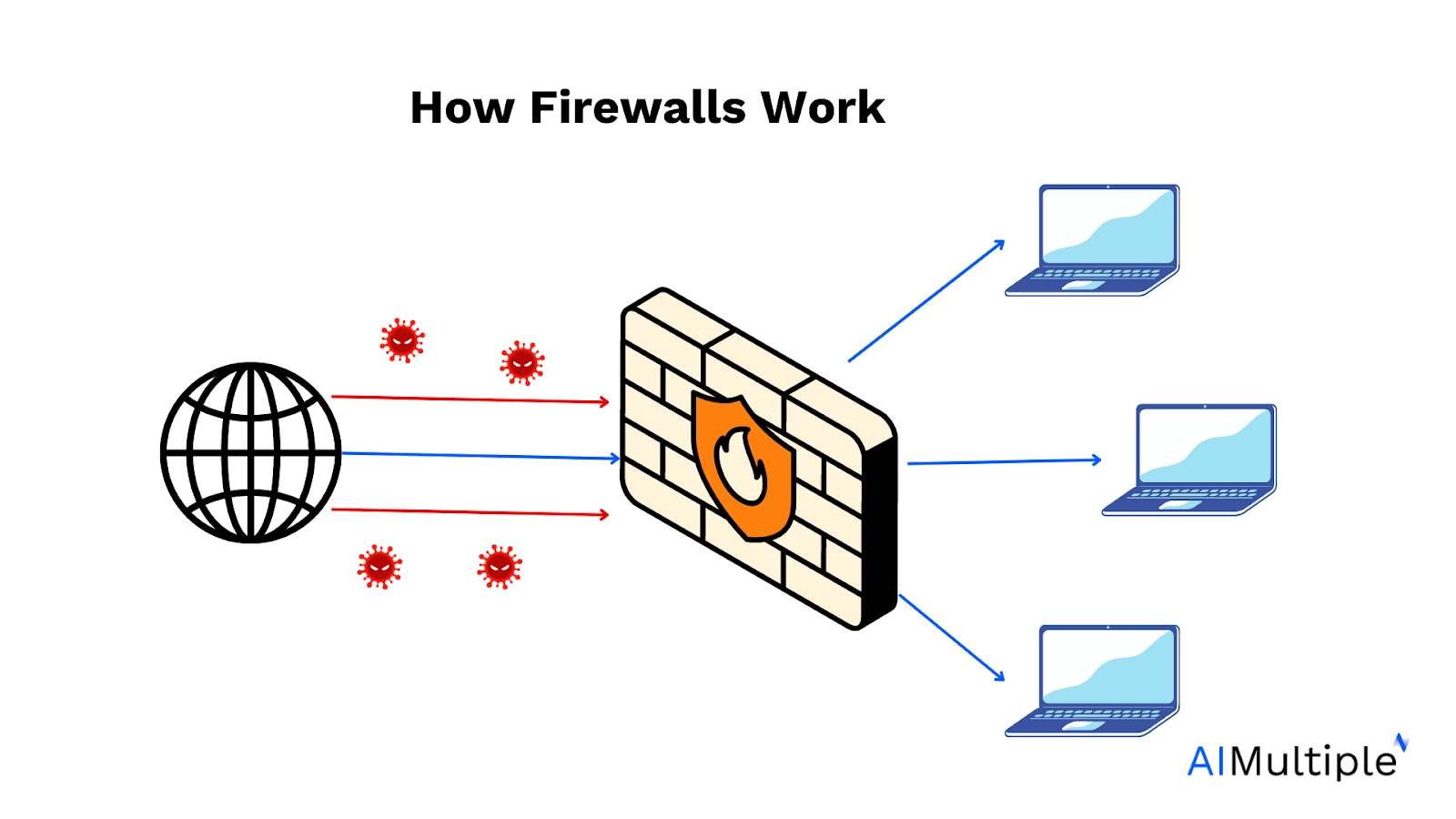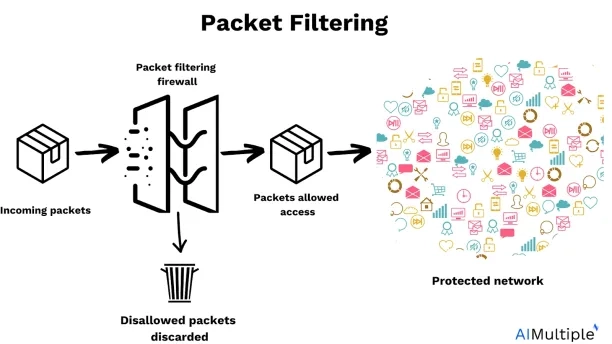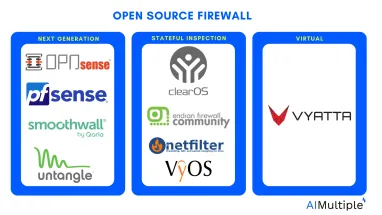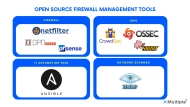Network security statistics reveal that
- The average cost of a data breach is approximately $4 million and increasing over time.
- Organizations are saving ~$2 million annually by relying on network security solutions such as next generation firewalls (NGFWs), AI network security, and network security automation technologies compared to those that rely solely on traditional security measures.
Open source firewalls provide a cost effective solution to network security. Explore the features, types, and challenges of top open source firewalls as well as a comparison of open source firewalls and commercial firewalls:
Comparison of Top 9 Open Source Firewalls
| Tool | Github Star | Rating | Network address translation | Packet filtering | Type |
|---|---|---|---|---|---|
| pfSense | 4.7K | 4.6 out of 289 reviews | ✅ | ✅ | Next generation firewall |
| OPNsense | 3K | NA | ✅ | ❌ | Next generation firewall |
| Vyos | 1K | 4.2 out of 13 reviews | ✅ | ❌ | Stateful inspection firewall |
| ClearOS | 230 | NA | ❌ | ❌ | Stateful inspection firewall |
| IPFire(Netfilter) | 150 | NA | ✅ | ✅ | Stateful inspection firewall |
| Untangle | 20 | 4.7 out of 44 reviews | ❌ | ❌ | Next generation firewall |
| Smoothwall | 0 | 4.6 out of 3 reviews | ✅ | ❌ | Next generation firewall |
| Endian Firewall | NA | 4.4 out of 9 reviews | ✅ | ❌ | Stateful inspection firewall |
| Vyatta | NA | 5 out of 1 review | ✅ | ❌ | Virtual firewall |
* Based on data from B2B review platforms
** Based on data from LinkedIn
Inclusion criteria: To be included in the table, the vendor must have at least one user review on B2B review platforms or at least one star on GitHub.
Ranking: The companies are ordered based on the total GitHub stars.
1. pfSense
pfSense allows users to modify the default configuration file to suit their needs. It scales well for growing networks with support for multiple interfaces and caters to advanced users through a command line interface. pfSense acts as a next-generation firewall, providing both NAT and packet filtering capabilities.
2. OPNsense firewall
OPNsense firewall is an open source next generation firewall known for its web based management interface that simplifies configuration and management. It includes an intrusion detection system (IDS) and web filtering to block malicious network traffic and supports virtual private networking (VPN) for secure remote internet access.1 OPNsense project offers both network address translation (NAT) and robust security features, making it a versatile choice for various network environments.
3. VyOS
VyOS is a fully open-source firewall software with a community-driven development approach. It focuses on network uptime and supports high availability with hardware appliance deployment. VyOS is a stateful inspection firewall with a network address translation feature, which make it suitable for environments requiring robust and continuous network performance.
4. ClearOS
ClearOS is a stateful inspection firewall without NAT or packet filtering capabilities. It provides a simple solution for basic network security needs, which makes it suitable for users looking for a straightforward and manageable firewall option.
5. IPFire (Netfilter)
IPFire is a stateful inspection firewall focusing on security with features like web filtering to block unwanted websites and content. It emphasizes intrusion detection as well as intrusion prevention and supports hardware failover to ensure high availability. IPFire combines network address translation with packet filtering, providing a comprehensive security solution for demanding networks.
6. Untangle NG Firewall
Untangle NGFW has an intuitive user interface and comprehensive security features, including intrusion detection and prevention. Although it lacks NAT and packet filtering, Untangle NGFW supports deployment in virtual machine environments, offering flexibility for diverse network setups.
7. Smoothwall
Smoothwall is a next-generation firewall known for its user-friendly web-based interface. The firewall includes network address translation but lacks packet filtering capabilities. Smoothwall is designed as a simple and effective firewall solution without advanced customization requirements.
8. Endian Firewall
Endian Firewall Community is a stateful inspection community edition firewall that supports network address translation. It offers a reliable security solution with a focus on ease of use and community support. Although it lacks packet filtering, its stateful inspection capabilities ensure secure and efficient traffic management.
9. Vyatta
Vyatta provides a virtual firewall solution with network address translation capabilities. It is designed for virtual environments, offering flexibility and scalability. While it doesn’t include packet filtering, it is well suited for network setups that prioritize virtualization and ease of deployment.
What is an open source firewall?
Figure 1. Schematic representation of firewalls’ working process

A firewall is a network security system that monitors and controls incoming and outgoing traffic based on predefined security rules, creating a barrier between a trusted network and an untrusted network.2
Open source firewalls are security systems distributed under an open source license, meaning their source code is freely available for anyone to view, modify, and distribute. This transparency allows users to verify the security of the code and customize the firewall to meet their specific needs. Open source firewalls strike a balance between security, cost effectiveness, and flexibility, offering a viable alternative to commercial firewall solutions.
Features of open source firewalls
Features of open source firewalls include, but are not limited to, the following:
1. Network address translation (NAT)
Figure 2. Schematic representation of NAT

Source: Wikipedia3
Network address translation (NAT) is a technique used in networking to modify the source or destination IP addresses of packets as they pass through a router or firewall. NAT enables multiple devices on a local network to share a single public IP address, conserving the number of public IP addresses an organization needs. It provides a level of security by hiding internal IP addresses from external networks.
Impact on firewalls:
Security: NAT provides a layer of security by masking internal IP addresses from external networks, making it harder for attackers to target specific devices within a network.
Scalability: It allows multiple devices to share a single public IP address, which is particularly useful for conserving IP address space in large networks.
Flexibility: NAT can simplify network management and reconfiguration, especially during network expansion or changes in the ISP-provided IP addresses.
2. Packet filtering
Figure 3. Schematic representation of packet filtering

Packet filtering is a firewall technique that controls network access by monitoring outgoing and incoming packets and either allowing or blocking them based on a set of predefined security rules. These rules can be based on various packet attributes such as IP address, protocol, port number, and more.
Impact on firewalls:
Security: Blocking unauthorized access and allowing only legitimate traffic based on established rules, packet filtering enhances security. It helps prevent various types of attacks such as IP spoofing and port scanning.
Control: Administrators can define detailed rules to control traffic flow, ensuring that only necessary and secure connections are allowed.
Performance: Stateless packet filtering is faster but less secure, while stateful filtering provides better security at the cost of increased processing overhead.
Types of open source firewalls
Next generation firewalls (NGFWs)
Next generation firewalls (NGFWs) extend beyond traditional firewall capabilities by incorporating advanced features such as application awareness, integrated intrusion prevention, and threat intelligence. They offer deep packet inspection (DPI), enabling them to identify and control applications, regardless of port, protocol, or evasive tactics.
Benefits:
- Enhanced security through application level controls and threat intelligence.
- Improved network visibility and control.
- Integration with other security tools for comprehensive protection.
Challenges:
- NGFWs require expertise to configure and manage advanced features.
Stateful inspection firewalls
Stateful firewalls, also known as dynamic packet filtering firewalls, monitor the state of active connections and make decisions based on the context of traffic. They maintain a state table to keep track of active sessions and allow or block traffic based on the state and context of the connection.
Benefits
- Enhanced security through monitoring and maintaining the state synchronization of connections.
- Efficient resource utilization by traffic shaping based on session states.
- Comprehensive logging and reporting for better network management.
Challenges:
- Stateful firewalls require technical knowledge to set up and configure it effectively.
- It may involve complex rule configurations for advanced security policies.
Virtual firewalls
Virtual firewalls operate in virtualized environments, providing security for virtual machines (VMs) and virtual networks. They are deployed as software instances within virtualized infrastructure and offer similar functionalities to physical firewalls, including packet filtering, NAT, and VPN.
Benefits
- Flexibility to secure dynamic and scalable virtual environments.
- Cost-effective solution for organizations using virtualized infrastructure.
- Easy integration with cloud services and virtual network functions (VNFs).
Challenges:
- Performance may vary depending on the underlying virtual infrastructure.
- It requires expertise in virtualization and network security to configure and manage.
Open source firewalls vs commercial firewalls
When opting for an open source firewall, the cost benefit ratio is crucial. Unlike commercial firewalls with vendor support, open source solutions rely on internal expertise for maintenance and troubleshooting. This can be manageable with a skilled support team but may pose challenges in smaller companies where reliance on a single administrator could lead to significant costs for diagnosis and resolution without vendor assistance.4
Pros of Open source firewalls
- Openness of open source firewalls provides transparency and extensive customization, giving users the ability to adapt the firewall to their specific needs.
- Open source firewalls offer a balance between security, price, and customization.
Cons of open source firewalls
- Open source firewalls may lack commercial support, requiring users to rely on community members’ support.
- They may require more expertise to install and manage. Firewall configuration software and firewall management tools are helpful tools in the solution of this challenge.
- Customization options can be complex and time consuming in open source firewalls compared to commercial firewalls.
- Users may need to troubleshoot issues on their own rather than with the help of vendor support.
Challenges of open source firewalls
Open-source firewalls offer flexibility, cost-effectiveness, and customization, but they also come with challenges such as complex configuration, management, and monitoring. To address these challenges, various tools have been developed to aid in firewall configuration, management, auditing, and change management.
1. Configuration
Configuring open source firewalls can be a daunting task, especially for those who lack in-depth technical expertise. Firewall configuration software simplifies this process by providing user-friendly interfaces and automation capabilities.
2. Management
Managing open source firewalls involves tasks such as monitoring, updating, and maintaining firewall rules and policies.
3. Compliance
Checking firewall settings regularly helps catch problems early and avoid security gaps before they cause harm. Firewall audit software—whether open or closed source—saves time by quickly spotting rule errors and weak spots. It helps teams stay in control, especially when firewall settings change often.
4. Change management
Managing changes to firewall rules and policies is critical to maintaining network security and ensuring compliance. Network change management software helps track, approve, and document changes, reducing the risk of misconfigurations.
Configuration and change management capabilities are typically bundled together and offered by the same configuration and change management software.
FAQ
How can I choose the right open source firewall?
When selecting an open-source firewall, it is crucial to consider factors such as specific needs, budget, and network requirements. Evaluating the strengths and weaknesses of each firewall option will help in making an informed decision. The chosen firewall should align with the organization’s security goals and budget, providing a robust defense against potential cyber threats
What is a firewall?
A firewall is a system that filters information from the internet. It prevents unauthorized access from entering a private network. Thus, a firewall’s purpose is to create a safety barrier. It is possible to design filters by considering the following:
IP addresses
Domain names
Protocols
Programs/services
Ports
What are the differences between FWaaS, on premise and software firewalls?
The main difference between these types of firewalls is their protection areas.
Host-based firewalls: These types of firewalls are installed on a single computer. They can be an effective cybersecurity solution for firms with few employees. Additionally, some companies (with very sensitive data) or high-ranking executives may require host-based firewalls in addition to on-premise or cloud-based firewalls to secure private information from outsiders.
On-premise firewall: It is a network layer tool that uses a combination of software and hardware (servers) technologies. As a result, an on-premise firewall safeguards all devices in a greater area (an office for instance). It is suitable for traditional working where employees work in an office building. Similarly, military organizations or intelligence services of states can use such tools. However, geographical distance brings latency problems due to backhauling user traffic.
FWaaS: A cloud-based firewall is another name for it. FWaaS works independently of the network it protects. As a result, FWaaS systems filter internet traffic for their users from any location with the least amount of traffic latency. They are more easily integrated with cloud platforms due to their cloud native characteristics. In general, FWaaS products are appropriate for firms that embrace remote/hybrid working or have a large number of branches or offices in different geographical areas.
Further Reading
- Top +7 Open Source Firewall Options: Features & Types
- Firewall Integration of Top Management Services
- AI Firewall vs NGFWs: Detailed Analysis & Comparison
External Links
- 1. OPNsense® a true open source security platform and more - OPNsense® is a true open source firewall and more.
- 2. Internet security: firewalls and beyond: Communications of the ACM: Vol 40, No 5.
- 3. Network address translation - Wikipedia. Contributors to Wikimedia projects
- 4. Liu, D., Miller, S., Lucas, M., Singh, A., & Davis, J. (2006). Firewall policies and VPN configurations. Elsevier. Accessed: 30/May/2024.





Comments
Your email address will not be published. All fields are required.